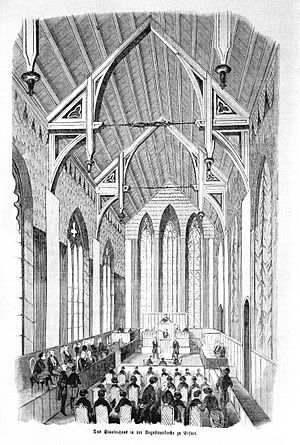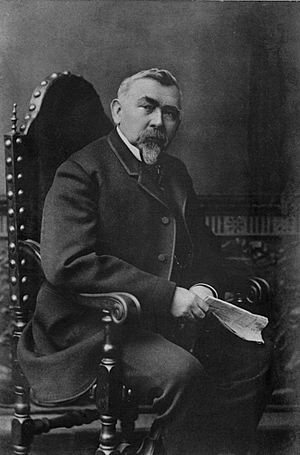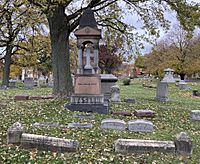Hermann Raster facts for kids
Quick facts for kids
Hermann Raster
|
|
|---|---|
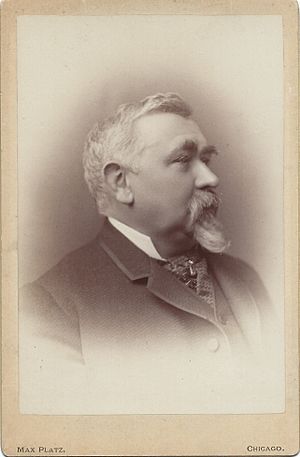 |
|
| Collector of Internal Revenue for the First District of Illinois | |
| In office December 1869 – March 30, 1872 |
|
| Preceded by | Edmund Jüssen |
| Succeeded by | Samuel A. Irvin |
| Secretary of the State Assembly of Dessau | |
| In office 1848–1851 |
|
| Personal details | |
| Born |
Wilhelm Friedrich Hermann Raster
May 6, 1827 Zerbst, Duchy of Anhalt-Dessau |
| Died | July 24, 1891 (aged 64) Bad Kudowa, Province of Silesia, German Empire |
| Resting place | Graceland Cemetery |
| Political party | Free Soil (1851-1854), Republican (1854-1891) |
| Spouses | Emilia Hahn Margarethe Oppenheim |
| Children | 4 |
| Alma mater | University of Leipzig, University of Berlin |
| Profession | Editor, journalist, politician |
| Signature |  |
Hermann Raster (May 6, 1827 – July 24, 1891) was an important American editor, writer, and politician. He was born in Germany and moved to the United States. Raster became the main editor and part-owner of the Illinois Staats-Zeitung. This was a very popular German-language newspaper. He used his newspaper to influence many German-American voters.
Raster helped convince the Republican Party to oppose the prohibition of alcohol in 1872. This was known as the Raster Resolution. President Ulysses S. Grant appointed him as a tax collector. However, Raster soon left this job. He is remembered for his many letters to important people like Joseph Pulitzer. These letters are now kept in the Newberry Library in Chicago.
Contents
Hermann Raster's Life Story
Early Life and German Revolutions
Hermann Raster was born on May 6, 1827, in Zerbst, Germany. His family was part of the German nobility. His father, Wilhelm Christian Raster, was a statesman. He was also a friend of Leopold IV, Duke of Anhalt. Wilhelm made sure Hermann learned English from a young age.
Hermann was very good at languages. He could speak seven languages after finishing school. He studied at the University of Leipzig and the University of Berlin. He learned about languages and history. But Hermann was more interested in journalism and politics.
In 1849, he became a stenographer for the Anhalt Legislature. Soon after, he became Secretary of the State Assembly of Dessau. Raster became a leader in the 1848 Revolution in Dessau. He wrote strong articles criticizing the government. In 1850, he became Chief Stenographer of the Erfurt Parliament. After the revolutions failed, Raster had to leave Germany. He chose to move to the United States in 1851. Many Germans who left after the failed revolutions were called Forty-Eighters.
Moving to New York
Raster arrived in New York City in July 1851. He first worked on a farm in Pennsylvania. In 1852, he moved to Buffalo and became an editor for the Buffalo Demokrat. His reputation as a journalist grew quickly. In 1853, Raster became editor of the New-Yorker Abend-Zeitung. This was one of the most important German-language newspapers.
He married Emilia Berta Hahn Raster, and they had a daughter named Mathilde in 1855. While in New York, he joined the Republican Party. He helped lead German-Americans to support the Republican Party in 1856. He wrote articles against slavery and for personal freedom. Raster was a strong supporter of Abraham Lincoln. He helped convince German and European communities to vote Republican.
During the American Civil War, Raster wrote for newspapers in Germany. He helped explain the American situation to people in Europe. He even went back to Germany to gain support for the Union. He also helped find investors for Union bonds. Until 1867, he worked at the U.S. Custom House in New York City.
Life in Chicago and Later Years
In 1867, Raster moved to Chicago. He became the editor of the Illinois Staats-Zeitung for A.C. Hesing. He worked there until he died. In 1868, Raster was a delegate at the 1868 Republican National Convention. He was the chairman of the platform committee. In 1869, he was appointed as the Collector of Internal Revenue for Chicago. This meant he collected taxes for the government.
During the Great Chicago Fire of 1871, Raster lost his home. The newspaper building and all its records were destroyed. But the Staats-Zeitung was the first newspaper in Chicago to print news of the fire. They managed to print less than 48 hours after the disaster. Later that year, President Ulysses S. Grant re-appointed him as Collector of Internal Revenue.
In 1872, Raster resigned from his tax collector job. He wanted more time for the newspaper and to help Grant's election campaign. That same year, at the Republican Convention, the "Raster Resolution" was added to the party's platform. This resolution strongly opposed the Temperance movement, which wanted to ban alcohol. Raster had a lot of influence over the German community. He threatened to leave the Republican Party if they didn't oppose prohibition. This would have meant the party losing many German votes.
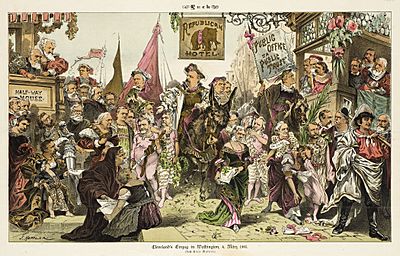
During the Haymarket Affair, Raster tried to calm the rioters. He left when he saw the situation was out of control. After the people responsible were caught, he wrote to Governor John Peter Altgeld. He suggested strong measures against them. He blamed recent German immigrants for the problems. He even suggested new immigration rules. In 1887, Raster proposed an "Anarchist Expulsion Bill" for Congress to discuss.
Raster was an active member of Chicago's smart and educated community. He was on the first board of the Chicago Public Library in the 1870s. He also served on the Chicago Board of Education for many years. He was also a trustee for the Field Museum of Natural History.
Death and Lasting Impact
Hermann Raster passed away on July 24, 1891, in Kudowa-Zdrój, Germany. He had traveled there in June 1890 because his health was failing.
His body was brought back to the United States. On August 12, his funeral was held at the German Press Club in Chicago. People came from New York and New Jersey to attend. The hall was decorated, and his casket was covered in flowers. The German American Press Club of Philadelphia sent a large anchor. The German Club of Hoboken, New Jersey sent a laurel wreath. It was wrapped in the colors of the 1848 revolution, which Raster had been a part of.
After his death, the Chicago Tribune newspaper wrote about him. They said his writings during and after the Civil War helped people in Germany understand America. They also helped the U.S. sell bonds in Europe. Raster was buried at Graceland Cemetery in Chicago on August 13, 1891. His grave is still there today.
In 1891, Raster's family and friends published a book. It was called "Reisebriefe von Hermann Raster" and included his travel papers and biography. Over 3,900 of his papers, letters, and writings were given to the Newberry Library in 1893. In 1893, the Hermann Raster School opened in Chicago. A larger Hermann Raster Elementary School was built in 1910. Today, it is called The Montessori School of Englewood.
Raster's son-in-law was the Chicago architect Arthur Hercz. His granddaughter Corrine married Bruce Krasberg, an industrialist and gardener from Chicago.


